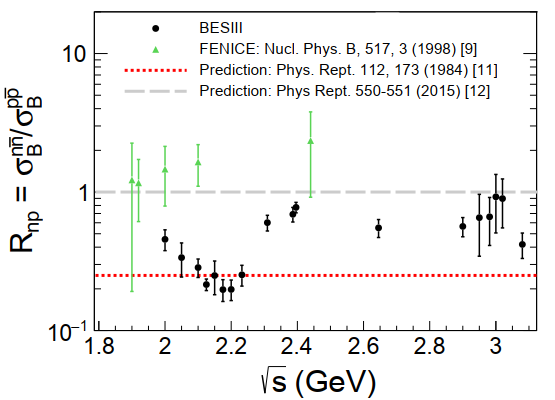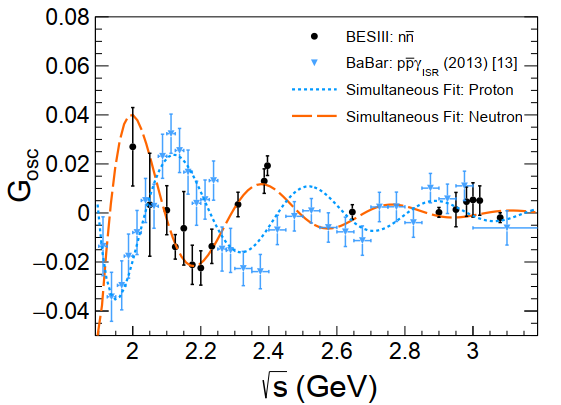

The BESIII collaboration has presented measurements of the neutron’s electromagnetic (EM) structure in the time-like region with unprecedented precision. The new BESIII results clarify the photon–nucleon interaction puzzle that has persisted for over 20 years, and a surprising periodic structure has been observed on the nucleon effective form factors. The manuscript is featured on the cover of the Nov. 8 issue of Nature Physics.
As an uncharged particle, the neutron resists many types of measurement. Ninety years after its discovery there are still many unanswered questions, in particular concerning its size and lifetime. The neutron consists of three quarks that whirl around inside it and are held together by gluons. Physicists use EM form factors (EMFFs) to describe this dynamic inner structure of the neutron. These FFs represent an average distribution of electric charge and magnetization within the neutron and can be determined by means of experimentation. Quasi-elastic scattering experiments with 2H or 3He targets have been used to obtain neutron FFs in the space-like region, while the FFs in the time-like region are accessible in electro–positron annihilation experiments.
The first measurement of time-like neutron EMFFs was reported by FENICE in 1998. In this measurement, the photon–neutron interaction was observed to be stronger than the photon–proton interaction, an observation that is difficult to reconcile with theoretical expectations. Using 18 data samples collected at different center-of-mass energies, the BESIII collaboration measured the Born cross section of electron–positron annihilation reactions into a neutron and anti-neutron pair in a wide four-momentum transfer range from 4.0 to 9.5 GeV2. With these results and a recent publication by the BESIII collaboration on the Born cross section of


The measurements utilize data samples collected at BESIII with an integrated luminosity of 647.9 pb-1. Novel reconstruction methods have been applied to maximize detection efficiency. The difference in neutron reconstruction between data and simulation, as well as the trigger efficiency for the pure neutral process, have been carefully studied. The results improve the available statistics on the neutron FF by more than a factor of 60 over previous measurements. These data are now as precise as those obtained in corresponding scattering experiments. As a result, our knowledge of the FFs of the neutron will change dramatically, and we will get a far more comprehensive picture of this important building block of nature.
Article: The BESIII Collaboration. Oscillating features in the electromagnetic structure of the neutron. Nat. Phys. 17, 1200–1204 (2021). https://doi.org/10.1038/s41567-021-01345-6
News: https://doi.org/10.1038/s41567-021-01349-2
